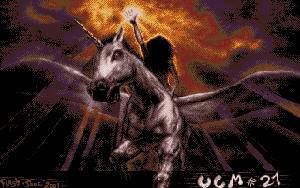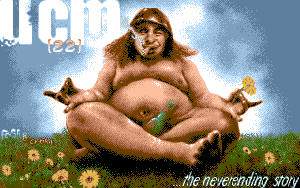Latest Developments in the Atari Diskmags Scene
Adok/Hugi
In these days in which not a lot of diskmags are released in the
whole scene, it becomes yet more interesting to take a close look
at the few who have not left us, regardless of the platform for
which they are released. On the occasion of the recent release of
Undercover Magascene #22 (in the middle of April 2002), I've taken
a peek on the recent development and the current state of the Atari diskmag scene.
 "Atari scene", that's a term that comprises the demomakers active on
such different platforms as the ST, a 16-bit computer from the middle
1980s which once was the most fierce competitor of the Commodore Amiga,
the Falcon, a newer architecture which made serious trouble for
486s in the early 1990s, and the Jaguar, which was the first 64-bit
video game console ever - it had already been established three years
before the development of the Nintendo 64.
"Atari scene", that's a term that comprises the demomakers active on
such different platforms as the ST, a 16-bit computer from the middle
1980s which once was the most fierce competitor of the Commodore Amiga,
the Falcon, a newer architecture which made serious trouble for
486s in the early 1990s, and the Jaguar, which was the first 64-bit
video game console ever - it had already been established three years
before the development of the Nintendo 64.
Since ST programs can be run on Falcon and PC too, in the latter case using a
free emulator such as PaCiFiST or SainT (available at
Little Green Desktop), most diskmags
are still based on ST shells. In fact, as we will shortly see, there are two
mags using a rather old engine that has seen hardly any changes since 1998.
Due to this, graphics and sound capabilities are restricted; the clear focus
of most Atari diskmags is the content. However, there are also a few Falcon
mags. As far as I know, there is hardly any active Atari demomaker who does
not own a Falcon, so the number of people from the target group who are unable
to read them is rather small, but of course ex-Atari users and those who've
never had an Atari won't be able to read these mags using their PCs.
Three years ago, we had the first Atari Diskmags Report in Hugi, to be
more precise Hugi #14. Back then there were two major magazines, the
Undercover Magazine (UCM), which had already reached issue 14 as well,
and Maggie, of which 26 issues had seen the light of
the day thus far. The first being published in Germany, the second in
England, both had international contributors, were targeted at an
international readership and featured in the former case mostly and in
the latter case only articles in the English language. Furthermore, there
was another active diskmag, Toxic Magazine. But this one was
en Francais and not intended to address anyone outside
la Grande Nation.
Similar to other magazines at other platforms at other times, UCM and
Maggie were struggling to become leaders in the scene. Of course this was
not a serious struggle, it was a competition driven by fun. The answer
to the question of who was the leader was left open, as both magazines
had their own diskmags charts in which, naturally, they themselves
were placed number 1 respectively. Basically it seemed that, like so often,
there were two factions in the scene, one being Maggie groupies, the others
defenders of the undercover crown.
The UCM adherents regarded their mags as more scenish, since it focused on
news and heaps of reviews of demos, music packs, diskmags and even ascii art
while containing only few non-scene articles - mostly jokes in German language
from an unknown origin. By contrast, Maggie was more open-minded towards other
topics, the scene section being just one of many. The games and game-dev
section was of the same size, and there were lots of stories and reports about
real-life as well as fictional happenings. At the same time Maggie also
featured more coding articles. Well, yeah, I see that you are smiling - or
at least I am.
UCM was directed by Moondog, a German editor and member of the demo
group .tSCc. (the sirius cybernetics corporation). He was (in)famous
for his harsh, opinionated reviews in which he did not hold back criticism,
no matter whether the respective production had been released by a friend
or foe of his. His writing was not too bad, never too short, sometimes
rather too long. However, his style very often appeared to be quite
spontaneous, which was shown by the frequent use of the words "hehe" and
"hmm". That's why MrPink, deputy editor of Maggie, once joked that Moondog
was probably living in Hmmburg.
Short after the review in Hugi, Moondog's scene activities were interrupted
by the loss of a very close relative. It was not easy for him to recover from
this shock, especially as it also meant that from now on he would have to
assume more responsibility for his remaining family. That was why he decided
to stop working on the magazine which he had been leading and filling with
articles for more than five years.

The new main editor was STsurvivor, the former editor of the French Toxic
Magazine. STS created issues 15 to 20 of UCM. Whilst issue 15 was still in
the Moondog style because Moondog had left quite a lot of articles to his
successor, he was on his own in the remaining issues. STS faced the problem
with which a lot of editors who aren't accustomed to writing everything
themselves are confronted: lack of contributions. So the fact that UCM
was released quite frequently, and once there was even just a month's time
between two issues, isn't due to a flood of articles; these issues were
simply small in content.
After UCM #20, STS resigned. At about the same time the last
issue of Maggie was released - 10 years after Maggie #1. The Atari scene was left without a major
diskmag. Then editors of both magazines, such as CiH, Paranoid and Exocet,
decided to team up and create a new mag. Born was Alive, the mag that
was supposed to show that the Atari scene was what its name indicated. One
former UCM editor, however, didn't join this move; instead, Grey of Mystic Bytes
founded another disk magazine, Chosneck. So far there
is only an issue. It is based on a Falcon engine which, according to the
review in UCM #22, looks very much like PC diskmags such as Hugi.
Whereas Chosneck apparently has a pretty modern interface,
Alive is embedded in the engine of the old Undercover Magazine. It looks
so much like older UCM issues that, if there wasn't the Alive logo, you'd
think you were reading yet another UCM edition. But in contrast to the last
UCMs, it did have quite a lot of content: about 70 articles per issue. The
first issue came out in early 2001. By now there are already four issues.
But, now comes the surprise: Short after Alive #1, UCM #21 was released under
the .tSCc. label; Moondog was back in business! Again he had created an issue
almost with only his own articles. The mag appeared in the same old, or let's
say classic style, it featured the same sections as before, a big news corner
and lots of reviews, including reviews of Alive and the last issues of UCM
with STS as the main editor - the headline is already very telling: "UCM at
its worst?".
A year later, in April 2002, UCM #22 came out, again mainly with Moondog
editorials, Moondog news, Moondog reviews - and, okay, Mc Laser party
reports.
Moondog is a veteran who is obviously very dedicated to the Atari scene and
loves writing about it. He also seems to feel responsible for his magazine,
which is very understandable, as he built it up himself, led it and dominated
its contents for several years. He is the example of a single person with
oustanding commitment - commitment strong enough to keep a whole scene alive.
Apart from those, some new mags saw the light of the day in Poland and
England: Syntax vs Underground and ST Offline respectively. At this point it seems to
be impossible to tell anything but that future will show us how they will
develop.
The latest two issues of UCM can also be read online at
sirlab.de. That's a very good move for those who want a
quick read without bothering to install an emulator and find out how to
handle that new, virtual system.
In conclusion, although Atari systems aren't widespread, the scene seems
to be still running, and there are still mags of some quality. I'm
personally not much attracted by reviews except sometimes mag-reviews,
but if that's what an editor wants to write, there's no reason to forbid
him to do so.
Adok/Hugi - 29 April 2002
 "Atari scene", that's a term that comprises the demomakers active on
such different platforms as the ST, a 16-bit computer from the middle
1980s which once was the most fierce competitor of the Commodore Amiga,
the Falcon, a newer architecture which made serious trouble for
486s in the early 1990s, and the Jaguar, which was the first 64-bit
video game console ever - it had already been established three years
before the development of the Nintendo 64.
"Atari scene", that's a term that comprises the demomakers active on
such different platforms as the ST, a 16-bit computer from the middle
1980s which once was the most fierce competitor of the Commodore Amiga,
the Falcon, a newer architecture which made serious trouble for
486s in the early 1990s, and the Jaguar, which was the first 64-bit
video game console ever - it had already been established three years
before the development of the Nintendo 64.
